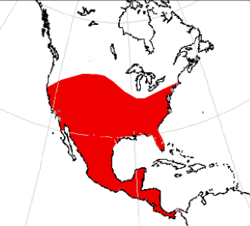Morphology
When alive, protoceratids would have resembled deer, though they were not directly related. Protoceratids ranged from 1 to 2 m in length, from about the size of a roe deer to an elk. Unlike many modern ungulates, they lacked cannon bones in their legs. Their dentition was similar to that of modern deer and cattle, suggesting they fed on tough grasses and similar foods, with a complex stomach similar to that of camels. At least some forms are believed to have lived in herds. [10]
The most dramatic feature of the protoceratids, however, were the horns of the males. In addition to having horns in the more usual place, protoceratids had additional, rostral horns above their noses. These horns were either paired, as in Syndyoceras , or fused at the base, and branching into two near the tip, as in Synthetoceras . In life, the horns were probably covered with skin, much like the ossicones of a giraffe. The females were either hornless, or had far smaller horns than the males. Horns were therefore probably used in sexual display or competition for mates. In later forms, the horns were large enough to have been used in sparring between males, much as with the antlers of some modern deer. [11]
This page is based on this
Wikipedia article Text is available under the
CC BY-SA 4.0 license; additional terms may apply.
Images, videos and audio are available under their respective licenses.

